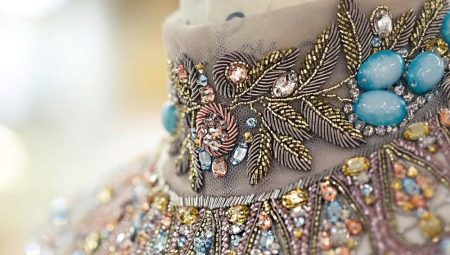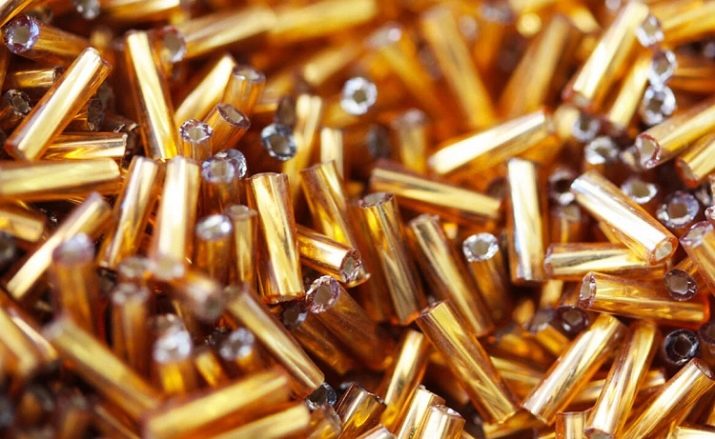All about bugles

In everyday life, many do not draw a line between glass beads and beads. But in vain, because these are two different materials, each of which has its own history, differs in production technology and scope. Different tools and techniques are used to work with them, and the finished works differ in their appearance. Let's figure out what a bugle is, and how it differs from ordinary beads, to which we are all accustomed.


What it is?
The main difference between bugles and beads is their shape. The first is most often tubes with thin walls and sharp edges, made of glass, less often - metal or plastic. The most common length of glass beads is from 3 mm. Bugles appeared in the 17th century in France and were initially used when working on wall panels.


In Russia, the material began to be actively used a little later, in the 18th century, and, again, for decorating premises. But soon the bugles move on to clothes. In the 19th century, they also actively decorate handbags, pipe cases, umbrellas, fans and other accessories. Floral and plant motifs prevailed in embroidery; later, themes from mythology were added to them.



Regarding the historical techniques for working with bugles, there were originally 3 of them.
- Fathom - first, the pattern was laid out with a cord, and already beads were strung on it.
- Attach - the drawing was first created on fabric, onto which bugles were later sewn on a wire.
- Lowering - bugles were strung on a thread, 2 threads crossed in a bead or went parallel. The method was used for working with small gizmos.
In addition, bugles were attached to wax, and later began to be glued. Both then and now the work with bugles was complicated by one of its peculiarities - sharp edges tearing the thread, wire and fishing line.But products from it come out light, and a wide range of colors - from transparent, monochrome black or white to bright, neon colors and patterns with a pattern - helps a lot in the embodiment of the most incredible ideas. Add to this bugle beads of non-standard shapes and get an irreplaceable material for the arsenal of a creative person.


Views
The main criteria by which bugles are usually divided into types are length, shape and coverage. Let's go through each.
By lenght
- 1 to 2 mm (felling) - the smallest and most popular bugle. It is often used in beading, as it goes well with beads.
- 2 to 5 mm - bugles for manual and machine embroidery.
- 3 to 7 mm Is the most common size. It is used in the decoration of clothing and interior items, embroidery, weaving.
- 4 to 10 mm - can be found in the production of jewelry and accessories.
- 5 to 12 mm - suitable for interior work and all kinds of crafts.
- 13 to 25 mm - the longest, interior bugle. Often they are the ones who embroider panels and paintings.
The bugle has a general size classification. Usually it is numbered from 1 to 5. But the size range may vary slightly from manufacturer to manufacturer.

By form
The shape of the bugle can be very different. You can find smooth, faceted or twisted models, with round, square or polyhedral holes.

By type of coverage
There is also a huge scope for choice:
- transparent bugles;
- transparent colored;
- opaque color, matte or glossy;
- metallic;
- transparent glass beads with a painted inner surface.
The paint is added to the glass while kneading the mass, or already ready-made beads are covered with it.


Materials (edit)
Already from the name it is clear that the most popular material for its manufacture will be glass. Cylindrical glass blanks are treated with a grinding mixture and poured into a special drum. The material becomes softer, thinner, lengthens, but retains the original cylinder shape.
Now you can find metal and plastic material. With the latter, you need to be especially careful - often the paint quickly peels off from it.

Popular manufacturers
The main manufacturers are the Czech Republic, China and Japan.
- Czech bugles - this is a time-tested and many professionals option. Among the firms, it is worth highlighting Preciosa Ornela with its variety of colors and sizes (from 1.6 to 35 mm). A variety of sections and shapes make your eyes run wild. You can get lost in the company's catalog for long hours.

- Japanese bugles are not far behind. TOHO materials are loved by designers around the world for their smooth edges that do not break the thread, and a huge selection of shapes and colors. Metallic, metallic matte, satin, rainbow, transparent, ultra-high gloss and even precious metal plated - there is definitely everything you need.

- Taiwanese and Chinese bugles will cost less than a branded one, but there is a great chance of running into a marriage. By the way, about him. During the production and sorting of Czech glass beads, 8% of beads are in the waste basket, and in the case of Japanese glass beads - 5% thanks to technological equipment.

Application
Initially, bugles were considered a purely interior material, but the years passed, and he managed to win his place in the production of bijouterie, jewelry, accessories, clothing, decor items. It can be found both on a wedding dress and on a figure skater's costume. Embroidery and fringe, combination with beads, beads and sequins. Hand embroidery with glass beads is especially valuable, since such products are always unique.


Even Coco Chanel began to skillfully combine bugles with precious metals and stones. To this day, glass beads jewelry and exquisite embroidery made by him are frequent guests of Chanel collections. Bugle beads can be found anywhere - from jacket trim to watch bracelets. And watching how the masters of a fashion house work with this material is a separate kind of pleasure.Especially when it comes to haute couture collections, where every stitch is a work of art.


But there are other examples as well. The famous Christian Dior Saddle clutch, embroidered with bugles, or the collection of the same Dior 2012, where these beads were everywhere, intertwining on the fabric in fancy patterns. Shoes, clothing and accessories Pradaworking from home Balmain... Perhaps, bugles at least once, but used by each of the famous brands. It's hard to argue that a vintage dress with fringe or bugle embroidery, especially in muted shades of pink, cream, or beige and gray, will still be a great choice when looking for a weekend outfit. And if we are talking about a wedding dress, then it is difficult to do without bugles - you can see it on the bodice, and on the hem, and even on gloves.
The material has not gone away from the interior design either. And here it can be found not only on curtains, bedspreads, decorative pillows and paintings. Wallpaper with bugles is a real miracle. Spectacular, adding chic to any space. The bugle beads are attached to the wallpaper using special glue and, if all the rules were followed during production, they are securely held there. One of the brightest historical examples of the use of glass beads in the interior can be seen in St. Petersburg. Magnificent panels once adorned the walls of the Glass Bead Study of the Chinese Palace in Oranienbaum: 12 panels of the 18th century amaze with the meticulousness of the work performed.


In jewelry, bugles also do not lose their positions. Earrings, bracelets and, of course, all kinds of beads and necklaces. A new wave of love for glass beads coincided with the popularity of ethnic-style jewelry. Matte or transparent bugles in basic colors - blue, red, yellow, ocher - are especially good for them. And if you are interested not in ethnicity, but in the 20s of the twentieth century, then earrings-brushes made of bugles and headbands embroidered with them will come to the rescue. Here the dominant colors will be red, pink, black and white.
If you yourself decide to work with this material, then it is worth remembering some rules that will simplify the process. After all, bugles are a rather complex material that requires attention and accuracy. Let's start with a choice. Decide in advance what color and size you need. And with what budget you are willing to allocate for this. This will make it easier to find.
Examine the edges of the beads carefully. They must be even, without visible defects. There should be no cracks on the edges.


Pour the bugles into the palm of your hand. Feel it with your fingers. The paint should not flake off and leave marks... Otherwise, the products will quickly lose their appearance and spoil the clothes. If you are going to embroider, then all the beads should be as calibrated as possible in size. It will be easier to work this way, and the finished product will have no flaws. Check if the line and needle go through the hole. If you see that bugles are stored in the sun, not protected from it in any way, think three times whether to acquire it or not. Even the finest quality material can fade with this treatment.
Now - to the intricacies of the work. Purchase containers for storing glass beads in advance. The bags tend to tear quickly. The best base for the material is reinforced thread, monofilament, wire or fishing line. The wire can break with frequent bending, the line can be frayed. The reinforced thread will last the longest. Needles should be taken thin and long. According to Russian numbering, №0.1 is suitable. It is best to pick up material with a needle, with your hands - only as a last resort.
When embroidering, pay attention to how the beads fit together and how they cover the thread.

In addition to thread and needles, the following are useful:
- nippers - they will make it easier to cut the wire;
- scissors;
- pliers;
- magnifier;
- ruler.
It is better to cover the place of work with a plain cloth with a nap. Provide good lighting for your work area, even when weaving or embroidering during the day. Keep animals and children away from the workplace, for their own safety.
As you can see, working with bugles is difficult.But the beauty and brilliance of the finished products will reward you for your efforts.






